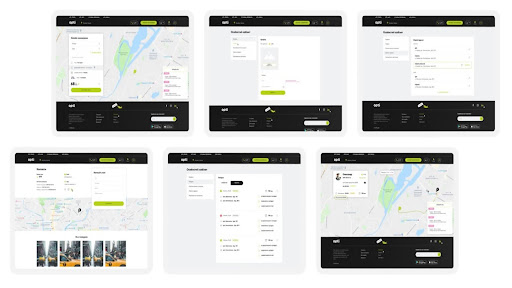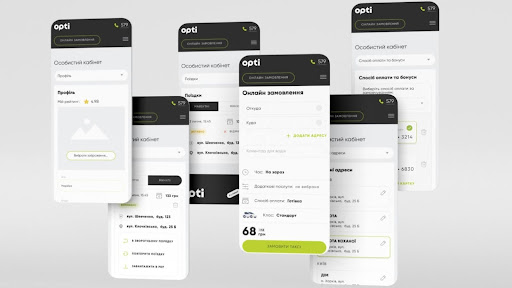THE CONTENT OF THE ARTICLE:
Task: to present dozens of services on one domain and simplify online ordering
Opti Global has a wide range of services: taxis in dozens of cities in Ukraine, freight transportation, medical transfers, an outsourcing call center, personnel recruitment, etc. The main problem with the redesign is fragmented communication: it is difficult for the user to quickly understand which directions are available, how to use them online, and where to place an order. Therefore, the Opti Digital studio had a goal: to design a corporate website that would simultaneously increase brand awareness, improve dialogue with the user, and neatly “lay out” all business areas into a single logical structure — with the ability to order a taxi online directly from the site.
Project goals and KPIs (as set)
- Recognition and trust. Present the brand and related directions in a single UX without overloading the main page.
- Conversion into action. Shorten the click-path to the main scenarios: “order a taxi”, “find out the rates”, “contact support”.
- Scalability. Ensure the growth of functionality without a “major overhaul” of the site - adding new sections and services without abandoning the basic core.

What we did: architecture, UX and content model
Information architecture (IA).
We deployed a “multi-service hub” model: on the first screen — a clear choice of scenario (call a taxi/other directions), inside — thematic landing pages for each direction. Direction cards are connected by two-way navigation and a single search on the site so that the user does not “get lost” when switching between services. This approach solves the main task of developing corporate websites — a balance between the breadth of the assortment and the speed of selection.
UX patterns for “quick” tasks.
- “Glue” CTAs on the first screen (“Order a taxi”), a minimum set of fields, clear step statuses.
- Consolidated blocks for additional services (freight, medical transfer, recruiting) — with short benefits and a “more details” button.
- Unified card and section templates — improve interface recognition, reduce cognitive load.
Content model and SEO foundation.
The direction pages received a single framework: a clear description, typical questions and answers, contacts, a call to action. Already at the static content level, basic SEO signals are laid: headings, ordered lists, internal links between sections, correct meta tags and predictable URLs. This is a fundamental part of any corporate website development that affects the indexing and CTR of snippets.
Technical outline: fast front, clean data, readiness for expansion
Implementation priorities are performance, stability and security. At the front level - adaptive layout, font and image optimization, lazy loading, cache layers. At the server logic level - a neat separation of functional areas (public pages, action widgets, service sections) so that individual directions can be developed without the risk of "breaking" the basic navigation. Built-in online taxi ordering function: the user places an order directly on the website without leaving a script.

Why this approach wins in Google’s results
- Intent compliance. Queries like “online taxi”, “medical transfer”, “taxi freight transportation” are closed by thematic pages; branded traffic goes to the main page, informational traffic goes to the desired “petal” of the hub.
- Pure IA → clear behavioral signals. The user finds the desired service faster → more targeted actions → stronger behavioral metrics.
- Technical discipline. Fast first display, stable layout, clear headings — all this reduces the bounce rate and speeds up indexing.
- Content scalability. The corporate website remains the “core” to which it is easy to attach new landing pages without changing the basic structure.
Results recorded by the customer
The team notes the growth of brand recognition, improved interaction with users and convenient provision of an expanded range of services; the key improvement was the ability to order a taxi online directly through the website. These effects are not “cosmetic”: they directly affect organic conversions and the load of offline support channels.
What affects the cost of developing a corporate website
- Discovery and structure. The more complex the service matrix, the more analytics (scenario maps, CTA prioritization, content frames).
- UI/UX design. A single design system saves budget on new sections and maintains brand integrity.
- Integrations. Order widgets, CRM/telephony, feedback forms — each bundle adds value, but also adds hours.
- Content and localization. Multilingualism (RU/UA/EN/PL) increases the amount of layout and testing, but expands coverage.
- Operation. Monitoring, updating, security, performance monitoring — a mandatory part of the estimate so that the site does not “get old” in six months.
Why Opti Digital?
- Experience in multi-service architectures. We divide the complex into understandable blocks, without losing integrity.
- SEO thinking "out of the box". Indexing and semantics are sewn into the structure, not screwed on after the fact.
- Transparent stages and estimates. The client sees what he is investing in and where the return appears.
You can leave a project application here: digital.opti.global
See the customer service itself: opti.global
Subscribe to updates
You will receive cool and useful material every week.








Write a comment
No comments